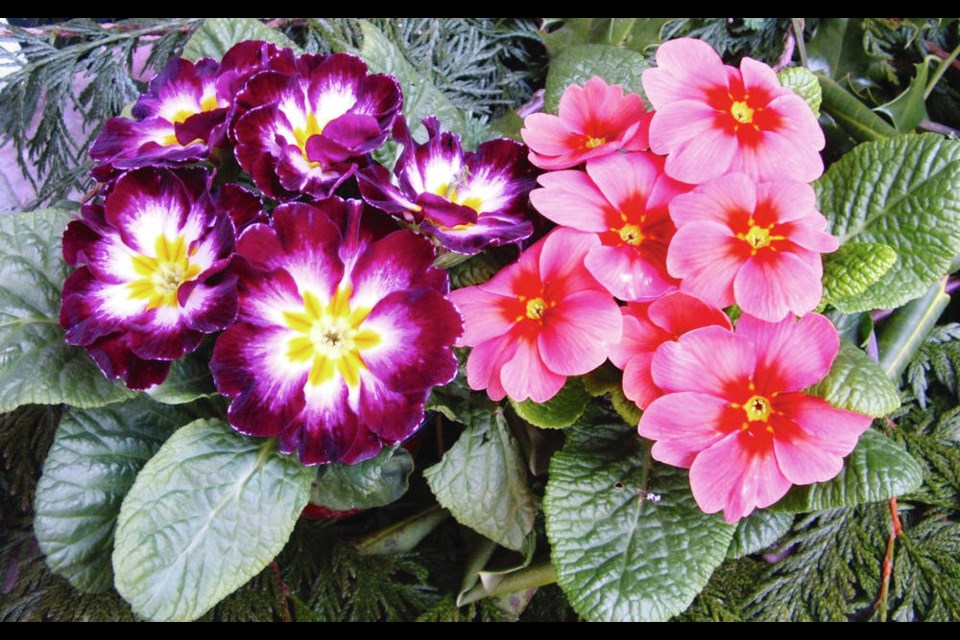Dear Helen: About ten days ago I noticed flowering primrose plants on shelving beside the entrance to the supermarket in my small town. Surely it’s too early to plant them outdoors. Are they sold this month as house plants?
R.A.
Every January, blooming primroses appear in most stores where plants are sold. For winter-weary people, they speak of spring. For gardeners, they are an advance taste of the new growing season.
A primrose plant full of flowers is hard to resist. I’m especially drawn to the fragrant ones, which are found mainly among the yellow and orange blooms.
It is early for planting outdoors. These January plants are usually acquired to enjoy as spirit-lifting points of colour and freshness indoors — where they commonly run into problems.
These are cool-season plants. Bringing a potted primrose into a cosy-warm room will cause a hasty collapse of leaves and flowers. To keep a plant perky for as long as possible, locate it at a cool windowsill exposed to full winter light. If no cool display area exists, place the plant in a cool spot at least at night.
An alternative for anyone with glass doors onto a patio, deck or balcony is to create a raised outdoor display of a few plants placed next to the doors where they can be enjoyed from inside the home. Later in the winter or early in the spring, transplant them into a garden.
Dear Helen: As you have suggested, I’ve made an inventory of seeds left on hand, to guide my seed acquisitions for this year. My question: For how many years will seeds remain able to germinate well?
G.S.
That depends on the type of seed and the conditions under which they have been stored. Most seeds will continue to germinate well and produce good plants for three years if they’ve been kept in a dark, dry, uniformly cool location. I store mine in a closet located against a north-facing outside house wall.
Some seeds will remain viable for up to twice as long. They include nasturtium, cucumber, zinnia, squash, cantaloupe, watermelon and beet.
Seeds that have short-lived viability include onion, leek, parsley, corn, larkspur, tender geranium (Pelargonium), salvia, strawflower and verbena. These are best kept for only one year; that is, sow only in two consecutive years.
To know how old seeds are, make it a habit to mark each packet with the year of purchase.
A note about pelleted seeds: A few years ago I began to notice that pelleted seeds germinated poorly or not at all in the year following purchase. On researching the issue, I found that the pelleting process reduces the seeds’ longevity. Pelleted seeds should be used within a year of purchase.
Seeds that are commonly pelleted are small ones, like carrots and lettuce. They are coated with a layer of clay to make them larger and therefore easier to handle and space accurately. Once pelleted seeds are sown, the coating absorbs moisture and softens, allowing the germinating seeds to push through to the soil surface.
Dear Helen: Is there way of eliminating lawn moss in winter without using products that could damage the environment and harm the birds in our garden? I limed the lawn in the fall, but moss is slowly taking over.
B.C.
Winter is not a good time for moss controls, which are more effective when rains abate and the soil begins drying.
Moss is almost ever-present in our coastal climate. Even if it is killed off, moss will return if conditions that favour its growth prevail. Conditions in which moss flourishes are shade, soil acidity, low soil fertility, poor drainage of excess moisture, and soil compaction. Where these conditions exist and are difficult to address, some people simply learn to like moss.
Where shade is an issue, consider pruning to let more light into the lawn area. Remove the lower limbs of trees and prune back large shrubs. When the soil has dried out a little in the spring, aerate to relieve soil compaction and improve drainage. Rake up the moss and follow with more liming. Top dress with a nourishing compost and overseed. If you can get grass plants growing vigorously, under improved conditions, the moss will be less likely to move in.



